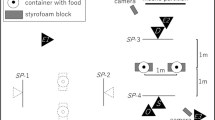Abstract
Dogs can use the placement of an arbitrary marker to locate hidden food in an object-choice situation. We tested domestic dogs (Canis familiaris) in three studies aimed at pinning down the relative contributions of the human’s hand and the marker itself. We baited one of two cups (outside of the dogs’ view) and gave the dog a communicative cue to find the food. Study 1 systematically varied dogs’ perceptual access to the marker placing event, so that dogs saw either the whole human, the hand only, the marker only, or nothing. Follow-up trials investigated the effect of removing the marker before the dog’s choice. Dogs used the marker as a communicative cue even when it had been removed prior to the dog’s choice and attached more importance to this cue than to the hand that placed it although the presence of the hand boosted performance when it appeared together with the marker. Study 2 directly contrasted the importance of the hand and the marker and revealed that the effect of the marker diminished if it had been associated with both cups. In contrast touching both cups with the hand had no effect on performance. Study 3 investigated whether the means of marker placement (intentional or accidental) had an effect on dogs’ choices. Results showed that dogs did not differentiate intentional and accidental placing of the marker. These results suggest that dogs use the marker as a genuine communicative cue quite independently from the experimenter’s actions.


Similar content being viewed by others
References
Agnetta B, Hare B, Tomasello M (2000) Cues to food location that domestic dogs of different ages do and do not use. Anim Cogn 3:107–112
Call J (2004) Inferences about the location of food in the great apes. J Comp Psychol 118:232–241
Call J, Tomasello M (1998) Distinguishing intentional from accidental actions in orangutans (Pongo pygmaeus), Chimpanzees (Pan troglodytes), and human children (Homo sapiens). J Comp Psychol 112:192–206
Call J, Tomasello M (2003) Social Cognition. In: Maestripieri D (ed) Primate psychology: the mind and behavior of human and nonhuman primates. Harvard University Press, Cambridge, MA, pp 234–253
Hare B, Call J, Tomasello M (1998) Communication of food location between human and dog. Evol Commun 2:137–159
Hare B, Tomasello M (1999) Domestic dogs (Canis familiaris) use human and conspecific social cues to locate hidden food. J Comp Psychol 113:173–177
Hare B, Brown M, Williamson C, Tomasello M (2002) The domestication of social cognition in dogs. Science 298:1634–1636
Miklósi Á, Polgárdi R, Topál J, Csányi V (1998) Use of experimenter-given cues in dogs. Anim Cogn 1:113–121
Soproni K, Miklósi Á, Topál J, Csányi V (2001) Comprehension of human communicative signs in pet dogs (Canis familiaris). J Comp Psychol 115:122–126
Soproni K, Miklósi Á, Topál J, Csányi V (2002) Dogs (Canis familiaris) responsiveness to human pointing gestures. J Comp Psychol 116:27–34
Tomasello M, Call J, Gluckman A (1997) Comprehension of novel communicative signs by apes and human children. Child Dev 6:1067–1080
Acknowledgements
The authors wish to thank Paul Harris for the basics of the idea for study 2 and we also thank the dog owners for their co-operation. The reported experiments comply with all laws of the country (Germany) in which they were performed
Author information
Authors and Affiliations
Corresponding author
Rights and permissions
About this article
Cite this article
Riedel, J., Buttelmann, D., Call, J. et al. Domestic dogs (Canis familiaris) use a physical marker to locate hidden food. Anim Cogn 9, 27–35 (2006). https://doi.org/10.1007/s10071-005-0256-0
Received:
Revised:
Accepted:
Published:
Issue Date:
DOI: https://doi.org/10.1007/s10071-005-0256-0




